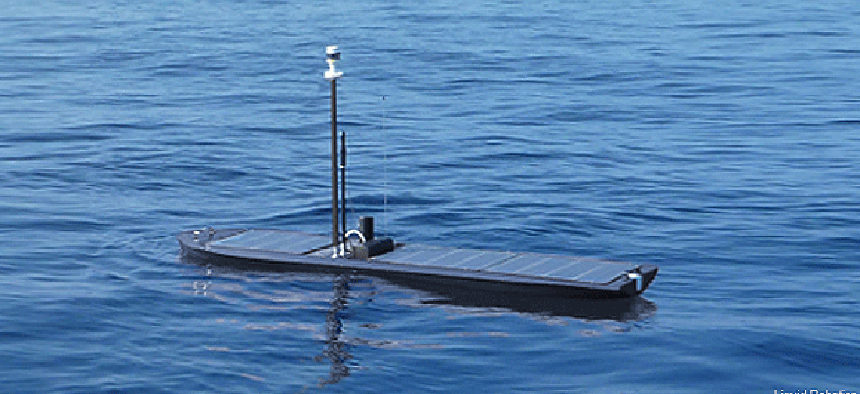Upgraded aquatic robot 'a server rack at sea'


Connecting state and local government leaders
The Wave Glider SV3, with room for an 8U rack, not only takes sensor readings but processes the data, only sending back the results.
Liquid Robotics, the company that builds the autonomous Wave Glider robots that helped NOAA break the ice on climate research has developed a new craft that improves upon the rugged original design and adds floating computer power.
The new Wave Glider SV3 is the world’s first hybrid wave- and solar-propelled unmanned ocean robot. The SV3 incorporates the latest advancements in energy harvesting technology, providing the ability to use both wave and solar energy for forward propulsion, the company said. The systems could help scientists explore portions of the world’s oceans in conditions that previously were too challenging or costly to operate.
Whereas the original Wave Glider could take sensor readings, the SV3 can be packed with enough onboard hardware to process data at sea. The results are transmitted back to its headquarters, saving bandwidth and time. "It's basically a floating server rack at sea," said Bill Vass, CEO of Liquid Robotics.
The SV3 also improves on how the craft gets around. The original robot could harness ocean waves for propulsion, so it never had to stop for fuel. But it was at times stymied by environmental conditions such as calm seas and strong currents pushing it off-course. The SV3s can have a backup thruster system installed which recharges from solar panels, providing extra speed, power and directional control when needed.
Vass said the SV3s run on open Linux with Java, and have enough space for an 8U equipment rack. However, the entire craft still fits within an airplane shipping crate, which Vass said was an important consideration for customers who need to get the new unit to faraway launch points. All data on the SV3 is encrypted both at rest and while in transit.
“Riding the advancements in consumer electronics, smart phone, tablet computing and a new generation of extremely capable processors, we are now able to provide processing onboard, actually as powerful as a supercomputer from not long ago,” said Roger Hine, CTO and inventor of the Wave Glider. “With that computational power and the ability to tirelessly swim across vast oceans, the Wave Glider SV3 represents a big step forward in the state-of-the-art of unmanned monitoring and exploration.”
The Wave Glider SV3 leverages the basic design principle of the Wave Glider SV2 platform, which was introduced in 2009 and has since traveled more than 300,000 nautical miles globally, set a world record for longest distance traveled by an autonomous vehicle (land or sea), and has been deployed on hundreds of customer missions ranging from the Arctic to Australia, and from the Canary Islands to Loch Ness.
Among the new advancements in the SV3 are hpc@sea (high performance computing), adaptable power and storage providing support for power hungry sensors, and the introduction of a new, adaptable operating system designed for intelligent autonomy for fleet operations.
In addition to launching the SV3 robot, company officials say that many of the advanced features onboard the new vessel will be brought over to the existing Wave Glider robots, which are now being designated as SV2s.




